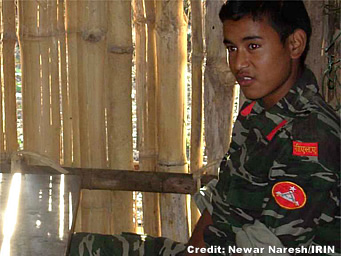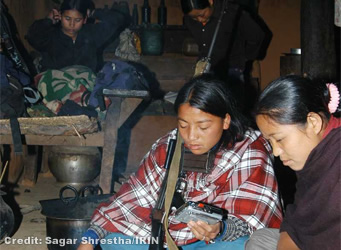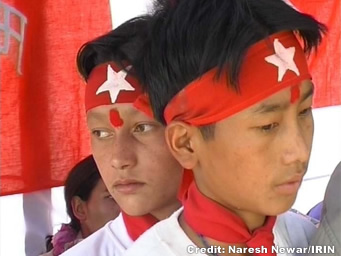|
Child
soldiers 'still recruited by Maoists' |
 |
SURKHET,
11 Jan 2007 (IRIN)
A
16-year-old youth, who was too afraid to reveal his real name, explained
how he managed to escape the Maoist People's Liberation Army (PLA) in December
2006.
"The
soldiers came to our village and recruited many boys and girls," he said,
speaking from the remote Kunathari village of Surkhet district, nearly
700 km northwest of the capital, Kathmandu. The boy said he managed to
run away from the training area in the village and is now in hiding with
relatives.
 |
| A
young Maoist recruit in a camp in Surkhet.
In
November 2006, the Maoist rebels signed a historic peace agreement with
the interim government of seven national parties to end their decade-long
conflict against the Nepalese state. The rebels and government also agreed
to manage arms and soldiers of the PLA and Nepalese army, as well as a
ban on the recruitment of children.
According
to government officials, about 35,000 Maoist soldiers have been confined
in seven main cantonment divisions and 21 satellite camps in the eastern
and western regions of the country. |
|
But
local human rights activists are still concerned that the Maoists have
not stopped recruiting civilians, especially children.
"We
have been monitoring the situation closely and we hope that the Maoists
release the child soldiers that they [allegedly] have been recruiting,"
said Usha Thapaliya from the local rights group Insec.
For
Nepalese families, help cannot come soon enough. "I want my son back at
any cost," said Lila Wali, whose 17-year-old son had been recently recruited
by the Maoists into its army.
 |
| Young female Maoists seeking refuge in a poor farmer's house. The family
feels uncomfortable about their presence - they fear the reaction of the
security forces if they find out that the family has sheltered rebels.
Thapaliya
said there was no accurate data on the number of child soldiers in the
PLA. Maoists, however, consistently deny recruiting children.
The
international children's watchdog, Watchlist on Children and Armed Conflict,
claimed in its 2005 report, 'Caught in the Middle: Mounting Violations
Against Children in Nepal's Armed Conflict', that up to 30 percent of the
Maoist forces may be children. |
|
"We
have not recruited children as soldiers and the human rights groups can
come and check our cantonment sites," said 'Dipak', vice-commander of the
seventh division of the PLA. He said young boys who had shown an interest
in joining their army were sent home.
Dipak
admitted that children worked as porters, messengers and performers in
Maoist cultural programmes but he explained they could not be categorised
as child soldiers.
According
to the United Nations children's fund (UNICEF), a child solider is any
boy or girl under 18 who is involved in any other capacity than combatant,
such as being a porter or an informer.
 |
Child
supporters of the Maoists - many are kidnapped or coerced into serving
with the rebels
The
Maoists offered US $70 per month and a good future, one 15-year-old boy
told IRIN. Poverty fuels their decision to join, he said. He had been working
as a porter in the Surkhet district and was then promoted to be a singer
in the Maoist cultural group.
"Some
of my friends fled after realising that there was hardship, heavy military
exercise and not much food," said the youth. |
|
"The
Maoist commanders who came to recruit us in the village said that there
would be a secure future, which is why many young boys are still living
in the camps," said a 17-year-old, who fled the camp because of the hard
training.
"Some
of my friends have been missing going to school and playing with their
friends as they are now soldiers and not children anymore. I hope to see
them one day soon," said another boy.
Both
young men did not want to be named for fear of reprisal.
The
UN has been assisting the country's arms management process and 35 arms
monitors are already in the country, according to the office in Kathmandu.
So far, the monitors have not yet been able to confirm the allegations
about children recruited and used by the Maoists.
Credit
IRIN 2007
Copyright
© UN Office for the Coordination of Humanitarian Affairs 2007
[
This report does not necessarily reflect the views of the United Nations]
Integrated
Regional Information Networks (IRIN), part of the UN Office for the Coordination
of Humanitarian Affairs (OCHA). |
 |
|






